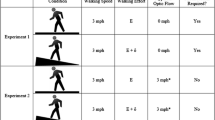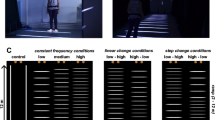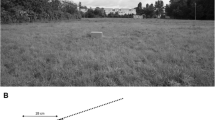Abstract
A visual illusion of perceived motion direction induced by treadmill locomotion is reported. Directionally ambiguous motions of shifting frames of sinusoidal horizontal gratings are perceived moving downward more frequently when the stimuli are shown in front of the observers’ feet while walking on a treadmill. To confirm this effect quantitatively, we asked naive observers to answer whether the direction of the motion of the grating pattern was perceived as upward or downward while they were walking or standing on a treadmill. The frequency of the “downward” response was significantly higher under the walking condition. This effect reveals that treadmill locomotion captures perceived direction of ambiguous motion in accordance with the direction of the optic flow during natural walking. This finding suggests that the effect reflects a perceptual mechanism to compensate for the absence of inputs in the action–perception cycle during locomotion.



Similar content being viewed by others
References
Anderson SJ, Mullen KT, Hess RF (1991) Human peripheral spatial resolution for achromatic and chromatic stimuli: limits imposed by optical and retinal factors. J Physiol 442:47–64
Bardy BG, Warren WH Jr, Kay BA (1996) Motion parallax is used to control postural sway during walking. Exp Brain Res 111:271–282
Brandt T, Dichgans J, Koenig E (1973) Differential effects of central versus peripheral vision on egocentric and exocentric motion perception. Exp Brain Res 16:476–491
Cavanagh P (1992) Attention-based motion perception. Science 257:1563–1565
Crane B, Demer J (1997) Human gaze stabilization during natural activities: translation, rotation, magnification, and target distance effects. J Neurophysiol 78:2129–2144
Culham J, Cavanagh P (1994) Motion capture of luminance stimuli by equiluminous color gratings and by attentive tracking. Vis Res 34:2701–2706
de Rugy A, Taga G, Montagne G, Buekers M, Laurent M (2002) Perception–action coupling model for human locomotor pointing. Biol Cybern 87:141–150
Durgin F, Gigone K, Scott R (2005) Perception of visual speed while moving. J Exp Psychol Hum Percept Perform 31:339–353
Ernst MO, Bülthoff HH (2004) Merging the senses into a robust percept. Trends Cogn Sci 8:162–169
Flückiger M, Baumberger B (1988) The perception of an optical flow projected on the ground surface. Perception 17:633–645
Fujimoto K (2003) Motion induction from biological motion. Perception 32:1273–1277
Fujimoto K, Sato T (2006) Backscroll illusion: apparent motion in the background of locomotive objects. Vis Res 46:14–25
Gibson J (1954) The visual perception of objective motion and subjective movement. Psychol Rev 61:304–314
Hansen T, Olkkonen M, Walter S, Gegenfurtner K (2006) Memory modulates color appearance. Nat Neurosci 9:1367–1368
Helmholtz H (1925) Helmholtz’s treatise on physiological optics translated from the third German edition, edited by James P. C. Southall, vol III [Electronic edition (2001): University of Pennsylvania URL: http://psych.upenn.edu/backuslab/helmholtz]. Optical Society of America
Ishimura G (1995) Visuomotor factors for action capture. Invest Ophthal Vis Sci (suppl) 36:S357
Ishimura G, Shimojo S (1994) Voluntary action captures visual motion. Invest Ophthal Vis Sci (suppl) 35:1275
Lee DN (1974) Visual information during locomotion. In: MacLeod RB, Pick HL Jr (eds) Perception: essays in honor of James J. Gibson. Cornell University Press, Ithaca/London, pp 250–267
Murakami I, Shimojo S (1993) Motion capture changes to induced motion at higher luminance contrasts, smaller eccentricities, and larger inducer sizes. Vis Res 33:2091–2107
Nakayama K, Shimojo S (1992) Experiencing and perceiving visual surfaces. Science 257:1357–1363
Nawrot M, Sekuler R (1990) Assimilation and contrast in motion perception: explorations in cooperativity. Vis Res 30:1439–1451
Ohtani Y, Ejima Y (1997) Anisotropy for direction discrimination in a two-frame apparent motion display. Vis Res 37:765–767
Paffen CLE, van der Smagt MJ, te Pas SF, Verstraten FAJ (2005) Center-surround inhibition and facilitation as a function of size and contrast at multiple levels of visual motion processing. J Vis 5:571–578
Patla AE (1997) Understanding the roles of vision in the control of human locomotion. Gait Posture 5:54–69
Pelah A, Barlow H (1996) Visual illusion from running. Nature 381:283
Ramachandran VS (1986) Capture of stereopsis and apparent motion by illusory contours. Perception & Psychophysics 39:361–373
Ramachandran VS (1987) Interaction between colour and motion in human vision. Nature 328:645–647
Ramachandran VS (1990) Interactions between motion, depth, color and form: the utilitarian theory of perception. In: Blakemore C (ed) Vision: coding and efficiency. Cambridge University Press, Cambridge, pp 347–360
Ramachandran VS, Anstis SM (1983) Displacement thresholds for coherent apparent motion in random dot-patterns. Vis Res 23:1719–1724
Ramachandran VS, Anstis SM (1990) Illusory displacement of equiluminous kinetic edges. Perception 19:611–616
Ramachandran VS, Cavanagh P (1987) Motion capture anisotropy. Vis Res 27:97–106
Ramachandran VS, Inada V (1985) Spatial phase and frequency in motion capture of random-dot patterns. Spat Vis 1:57–67
Tadin D, Lappin JS, Gilroy LA, Blake R (2003) Perceptual consequences of centre-surround antagonism in visual motion processing. Nature 424:312–315
Taga G (1998) A model of the neuro-musculo-skeletal system for anticipatory adjustment of human locomotion during obstacle avoidance. Biol Cybern 78:9–17
Verstraten F, Hooge I, Culham J, Van Wezel R (2001) Systematic eye movements do not account for the perception of motion during attentive tracking. Vis Res 41:3505–3511
Wallach H (1987) Perceiving a stable environment when one moves. Annu Rev Psychol 38:1–27
Warren WH, Kay BA, Yilmaz EH (1996) Visual control of posture during walking: functional specificity. J Exp Psychol Hum Percept Perform 22:818–838
Warren WH, Kay BA, Zosh WD, Duchon AP, Sahuc S (2001) Optic flow is used to control human walking. Nat Neurosci 4:213–216
Wohlschläger A (2000) Visual motion priming by invisible actions. Vis Res 40:925–930
Acknowledgments
We thank Shinsuke Shimojo for many helpful comments on the manuscript.
Author information
Authors and Affiliations
Corresponding author
Rights and permissions
About this article
Cite this article
Yabe, Y., Taga, G. Treadmill locomotion captures visual perception of apparent motion. Exp Brain Res 191, 487–494 (2008). https://doi.org/10.1007/s00221-008-1541-3
Received:
Accepted:
Published:
Issue Date:
DOI: https://doi.org/10.1007/s00221-008-1541-3




